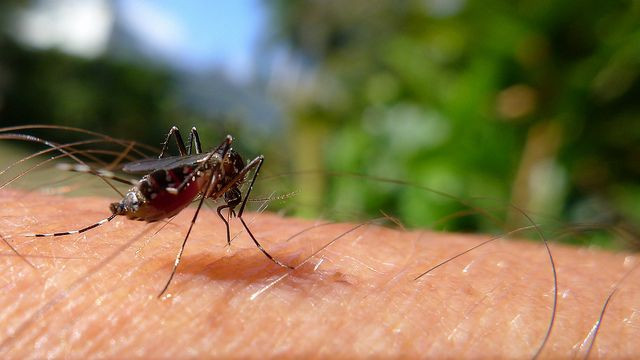A Cookbook For West Nile Virus: The Best Ingredients For An Outbreak

With the apex of mosquito season just around the corner, a major study from the University of Texas-Southwestern reveals clues that explain last year's monumental West Nile virus outbreak, the worst in American history.
But what created this perfect storm for a mosquito-borne virus that has fluctuated in prevalence since it was discovered back during 1999 in New York?
The brunt of the 2012 epidemic was felt by Texas, recording 1,800 of the nation's 5,600 cases from May to December (California was a far second with 480 cases). Dallas, in turn, was the hardest hit city in the U.S.
Researchers at UT-Southwestern, along with public health officials, reviewed the history of West Nile for Dallas in search of answers, and came up with the four ingredients that contributed to the severity of last year's outbreak.
1. 'Set your oven' to 28°F
The stage was most likely set for West Nile months before the first Dallas case was recorded. The authors maintain that a warm winter preceded the 2012 epidemic as well as the 2006 season, the 2nd worst in the city's history.
The number of days with a hard freeze — a temperature < 28 °F — was the best meteorological predictor for the subsequent severity of the West Nile season. Accoring to the National Weather Service, Dallas tied a record for fewest freeze days during the winter before the 2012 outbreak.
Fewer winter days without the temperature, according to authors, could mean more mosquitoes during the summer.
"In Dallas' temperate climate, the effects of the lack of a hard winter freeze on West Nile virus activity would be expected to allow more infected female mosquitoes to survive the winter," wrote the authors, who were led by Dr. Robert Haley, chief of epidemiology and professor of internal medicine at UT Southwestern.
2. Pick the "ripest" mosquitoes
Want to know how bad West Nile will be in the coming months? Ask the mosquitoes, not the people. It's a common reflex to base the severity of the situation on how many people are infected, but this is a poor real-time readout because humans can 'silently' carry the disease for weeks before displaying symptoms. When you combine this with the time that it takes to complete laboratory to diagnosis the virus — one week — there is a tremendous lag time between catching the disease and public awareness.
The most important number for local public officials to know is the "mosquito vector-index," which is calculated from both the abundance of mosquitoes and the percentage of mosquitoes infected with West Nile virus.
"When the vector index goes above 0.5 early - in June or July - large numbers of people are silently infected, and this is the best time to intervene," said Dr. Haley, "In years when the vector index did not rise until late July or August, impending outbreaks just sputtered - in late summer mosquito abundance declines, and mosquitoes become less active and stop biting as much."
Measuring how many mosquitoes have the disease, via trapping and surveillance, is the real key to early intervention, according to the authors.
"Acting early from the vector index rather than after human case reports and deaths mount up can nip an outbreak in the bud," continued Haley.
3. The World's Greatest Cooks: Humans
Another crucial ingredient to the Dallas outbreak was humans, and not because we carry the disease, but because of how we live in urban settings.
House mosquitoes are more likely to transmit the disease than insects that fly around in the woods or in a field, according to the researchers, who looked at which neighborhoods were most affected by the outbreak
The authors found that wealthier communities had a greater risk, which mirrored findings from previous studies. This trend is potentially due to these areas having more neglected outdoor pools, given mosquitoes need standing water to breed. In addition, higher housing density and areas with a large quantity of unoccupied houses were also more likely to be plagued by West Nile.
4. Tips For Fixing The Recipe
So far, 2013 is looking like a less dangerous year for the virus, but we're not out of the woods yet, as August is typically the worst month of the year for the disease.
Given there is no drug treatment, public awareness and education are arguably the best defenses against mosquitoes and West Nile virus. During the summer of 2012, government officials in Dallas and other cities with widespread disease opted to spray insecticides to quell an outbreak, but in the future most of us will need to rely solely on our savvy and luck.
It's important to remember that the highest mosquito activity is witnessed at dawn and dusk, so applying bug spray during these times is essential. For hikers, kayakers, and general outdoorsmens, clothing retailers have begun selling shirts and bandanas with repellant woven into the fabric.
To mosquito-proof your home, the U.S. Centers for Disease Control and Prevention recommends replacing old, broken window screens and emptying standing water in gutters, flowerpots, and pet water dishes on a regular basis.
Weather and population density vary from town to town and city to city, which can impact mosquito dynamics. Public officials should take the initiative to trap and surveil mosquitoes in their region, so they have a firm understanding of how these pests may behave during a future outbreak. In turn, people should contact their local public health officials to learn the details on how West Nile is striking their area and for information on how to best protect their homes.
Sources: Chung WM, Buseman CM, Joyner SN, et al. The 2012 West Nile Encephalitis Epidemic in Dallas, Texas. JAMA. 2013.
Petersen LR, Brault AC, Nasci RS. West Nile Virus: Review of the Literature. JAMA. 2013.



























